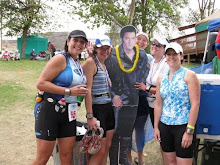For Active.com
If you're at a point in your training where you need to move toward some higher intensity rides, but the weather is keeping you on the indoor trainer, this column can help. The indoor trainer workout shown below begins with pedaling form and then goes into a set that provides a mixed-intensity ride.
You can repeat the main set as many times as you please; but completing the recommended number of repeats shown makes the total workout time between 45 and 60 minutes.
Bad weather can't take your fitness away--ride on!
Warm-up
| 5-10 minutes | Ride comfortably within the range of Zone 1 to 2 intensity or an easy, aerobic warm-up |
| 10 minutes | 5 x (30 second with the right leg doing most of the work, 30 seconds where the left leg does most of the work, 60 seconds with both legs working to form smooth, relaxed circles) |
| 12 minutes | 4 x (both legs working for 30 seconds at 90 rpm, 30 seconds at 100 rpm, 30 seconds spinning at more than 100 rpm (keep your fanny from bouncing off of the bicycle seat with controlled, high speed spinning), recover with 1:30 of easy spinning) |
Main Set (20-30 minutes)
Repeat the set below 2 or 3 times:
| 2 minutes | Zone 2 intensity (recover with easy spinning in Zone 1 for 2:00) |
| 1 minute 30 seconds | Zone 3 intensity (recover with easy spinning in Zone 1 for 1:30) |
| 1 minute | Zone 4-5a intensity (recover with easy spinning in Zone 1 for 1:00) |
| 30 seconds | Zone 5b intensity, powerful riding seated or out of the saddle standing (recover with easy spinning in Zone 1 for 0:30) |
Cool Down
8-13 minutes | At a low resistance, spin easy at Zone 1-2 intensity |
Notes:
You can find intensity references here:
http://www.active.com/images/activeTrainer/Training_Intensity.pdf
If your trainer provides power numbers, be certain your power output increases throughout the main set repeats. In other words, the power output for the one-minute work bout should be higher than it was for the two-minute work bout.
Record your average power outputs for each work bout in your journal.
If you repeat the workout once per week, or once every other week, aim to have a slight increase in the average power output within the main set, over the course of time.
Optimally, over the course of several weeks your average power output will increase while your heart rate remains the same, or slightly lower.
Gale Bernhardt was the USA Triathlon team coach at the 2003 Pan American Games and 2004 Athens Olympics. Her first Olympic experience was as a personal cycling coach at the 2000 Games in Sydney. She currently serves as one of the World Cup coaches for the International Triathlon Union's Sport Development Team. Thousands of athletes have had successful training and racing experiences using Gale's pre-built, easy-to-follow cycling and triathlon training plans. Let Gale and Active Trainer help you succeed.
































